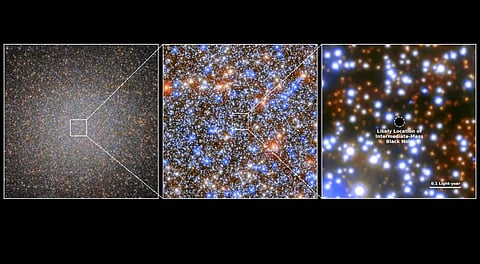

The long hunt for a long-theorised type of black hole has reached a successful conclusion. A new study, published in journal Nature, revealed compelling evidence of a massive black hole residing at the heart of the Omega Centauri star cluster. It is the closest of its kind to our solar system, only 18,000 light-years away.
The newly discovered black hole, estimated to be at least 8,200 times the mass of our sun, falls into the category of intermediate-mass black holes. Scientists believe these black holes formed during the early stages of galaxy evolution, filling a crucial gap in our understanding of black hole development.
Previously, astronomers had identified two main black hole classes: Stellar black holes, with masses around 20 times the sun or more; and supermassive black holes, residing at the center of galaxies and boasting masses millions to billions of times solar mass.
For years, scientists have been looking for intermediate-mass black holes, which are expected to range in size from one hundred to hundreds of thousands of times the mass of the Sun, or tens of thousands. Some candidates are awaiting confirmation.
Researchers have had their eyes on Omega Centauri for many years now, debating whether it hosts a black hole.
“Omega Centauri is a very peculiar object in the sky: It is the most massive globular star cluster in our Milky Way, but it also has been believed to be the core of a smaller galaxy that has been absorbed by the Milky Way,” Maximilian Häberle from the Max Planck Institute for Astronomy and the author of the study, told Down To Earth.
So far, the expert added that there was no definite proof of its existence. “We wanted to revisit this question using a large number of new and very precise observations with the Hubble Space Telescope,” he added.
The team of researchers analysed more than 500 Hubble Space Telescope archival images taken over two decades.
They then measured the velocities of 1.4 million stars and found seven fast-moving stars in a small region in the centre of Omega Centauri.
Häberle explained that the measured velocities of these seven stars were so high that they should depart from Omega Centauri in a relatively short period.
But they were still present. This, he added, could be attributed to the presence of a massive object, which was most likely gravitationally pulling them and preventing their escape. “The only object that can be massive enough is an intermediate-mass black hole with at least 8,200 solar masses,” he noted.
These new findings, the researchers wrote, help strengthen the evidence for an intermediate black hole in this star cluster.
These paper suggested that this could be the closest massive black hole for Earth. Our galaxy’s supermassive black hole, Sagittarius A*(Sgr A*), sits about 27,000 light-years away.
Intermediate black holes could help scientists understand how supermassive black holes can form very early in the history of the universe. “One potential pathway for the formation of these early supermassive black holes is by the merger of intermediate-mass ‘seed’ black holes.
However, the exact mass and frequency of these seeds are still unknown,” Häberle explained.
Next, the team plans to use the James Webb Space Telescope for a more precise measurement of the black hole mass. The telescope might also help scientists look for signs of material falling into the massive object at the centre of the star cluster. This, Häberle said, would provide independent confirmation of the findings.